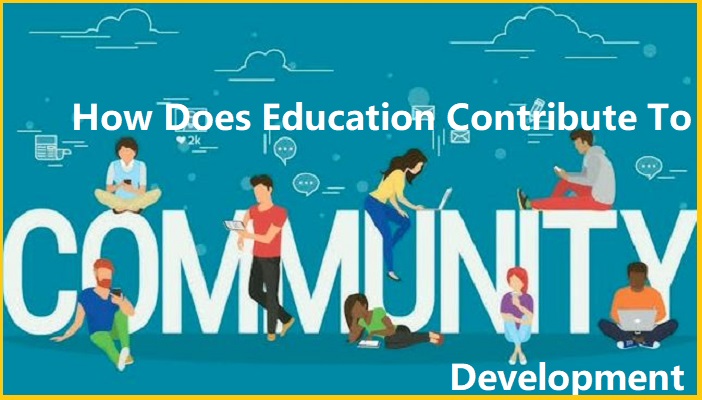Education plays a pivotal role in shaping not only individual lives but also the fabric of entire communities. You will get here an effective step-by-step guide on How Does Education Contribute to Community Development? It serves as a foundation for economic growth, social cohesion, health, and cultural identity.
Understanding the intricate relationship between education and community development is essential for creating vibrant, resilient, and sustainable communities. In this article, we will explore how education contributes to community development, examining various dimensions of this vital connection.
How Does Education Contribute to Community Development?
A Step-by-Step Guide on How Education Contributes to Community Development
1: Understand the Importance of Education
Recognize that education is a fundamental driver of economic growth, social cohesion, and overall community well-being. It empowers individuals with knowledge and skills essential for active participation in society.
2: Promote Workforce Development
Encourage the establishment of vocational and job training programs. These initiatives help residents gain skills that meet local labor market needs, reducing unemployment and fostering economic stability.
3: Foster Civic Engagement
Create educational programs that emphasize the importance of civic responsibility. Encourage community members to participate in local governance, volunteer work, and social initiatives to strengthen community bonds.
4: Implement Health Education Initiatives
Develop health education programs that inform community members about wellness, nutrition, and preventive care. Educated individuals are more likely to make informed health choices, improving overall community health outcomes.
5: Encourage Environmental Education
Integrate environmental studies into local curricula and community workshops. Raise awareness about sustainability practices and encourage participation in initiatives like recycling, community gardening, and conservation efforts.
6: Celebrate Cultural Heritage
Organize cultural education programs and events that highlight local traditions and diversity. This fosters pride in cultural identity and promotes inclusivity within the community.
7: Address Barriers to Education
Identify and tackle obstacles that prevent access to education, such as socioeconomic factors. Advocate for policies that support equitable education funding and provide resources to underprivileged communities.
8: Measure Impact and Adapt
Regularly assess the outcomes of educational initiatives on community development. Use feedback and data to adapt programs, ensuring they effectively meet the needs of the community.

Economic Growth and Workforce Development
Education is a critical driver of economic growth and workforce development. By equipping individuals with essential skills, educational consultant and enhances employability and fosters a more competent workforce.
Communities with higher educational attainment often experience lower unemployment rates, as educated individuals are more likely to secure stable jobs and contribute to local economies.
1. Case Study: Job Training Programs
For instance, many communities have successfully implemented job training programs that provide vocational education. These initiatives not only prepare residents for in-demand jobs but also stimulate local economies by attracting businesses looking for a skilled labor force.
2. Social Cohesion and Civic Engagement
Education also plays a significant role in p+romoting social cohesion and civic engagement within communities. When individuals are educated, they tend to participate more actively in community affairs, fostering a sense of belonging and shared responsibility.
3. Building Social Networks
Educated individuals often lead community initiatives, from neighborhood improvement projects to local governance. They create social networks that enhance trust and collaboration among residents, ultimately strengthening community ties.
Health and Well-being
The correlation between education levels and public health outcomes is well-documented. Communities with higher educational attainment generally exhibit better health metrics, as education promotes healthier lifestyles and informed decision-making.
Health Education Programs
Health education initiatives in schools and community centers can significantly impact public wellness. For example, programs focused on nutrition and physical activity can reduce obesity rates and improve overall health in communities.
Educated community leaders are often at the forefront of promoting these health initiatives, advocating for policies that prioritize community well-being.
The Impact of Education on Public Health in Communities
- Health Literacy: Education enhances health literacy, enabling individuals to understand medical information, make informed health choices, and effectively navigate healthcare systems.
- Preventive Care: Educated individuals are more likely to engage in preventive health measures, such as vaccinations and regular check-ups, reducing the incidence of disease within the community.
- Healthy Lifestyle Choices: Education promotes awareness of nutrition and fitness, leading to healthier lifestyle choices. This can result in lower rates of obesity, diabetes, and other chronic conditions.
- Mental Health Awareness: Education fosters understanding of mental health issues, reducing stigma and encouraging individuals to seek help when needed. This contributes to overall community well-being.
- Community Programs: Educational initiatives often lead to the development of community health programs, such as wellness workshops and health fairs, that provide valuable resources and support to residents.
- Economic Benefits: Improved public health outcomes reduce healthcare costs for communities, allowing for reinvestment in other vital services and infrastructure, thus promoting overall community development.
- Cultural Festivals and Events: Events such as cultural festivals, often organized by educational institutions or community groups, serve as platforms for cultural exchange and understanding. These celebrations enhance community pride and cohesion, reinforcing the value of education in promoting cultural identity.
Environmental Awareness and Sustainability
Education fosters environmental stewardship, encouraging individuals and communities to take action toward sustainability. By incorporating environmental education into curricula and community programs, residents become more aware of their ecological footprint and the importance of conservation.
Community Sustainability Initiatives
Successful community initiatives, such as community gardens and recycling programs, often stem from educational outreach. These programs not only improve the local environment but also bring residents together, reinforcing the community’s commitment to sustainability.
Challenges and Barriers to Education in Community Development
Despite its significant contributions, there are barriers to education that can hinder community development. Socioeconomic factors, such as poverty and limited access to resources, often affect educational opportunities.
- Overcoming Educational Barriers
To address these challenges, communities must develop strategies that promote equitable access to education. This includes advocating for policies that support funding for school programs, providing scholarships, and fostering partnerships between educational institutions and community organizations.
The Role of Education in Local Economic Growth
- Skill Development: Education equips individuals with essential skills, enhancing their employability and productivity. A skilled workforce attracts businesses and fosters economic diversification.
- Entrepreneurship: Educated individuals are more likely to start their own businesses. Education provides the knowledge needed for effective business management and innovation, driving local economic dynamism.
- Attracting Investment: Communities with higher educational attainment often attract more investments. Investors seek areas with a well-educated workforce, ensuring a steady supply of talent for various industries.
- Higher Earnings: Education typically leads to higher income levels. As residents earn more, they contribute to the local economy through increased spending, boosting demand for goods and services.
- Innovation and Technology: Educational institutions often serve as hubs for research and innovation. Collaborations between schools, businesses, and government can drive technological advancements that spur local economic growth.
- Community Resilience: A well-educated population is better equipped to adapt to economic changes and challenges, contributing to long-term stability and resilience in local economies.
In summary, education is a cornerstone of local economic growth, fostering a skilled workforce, promoting entrepreneurship, attracting investments, and enhancing community resilience.
How does education contribute to community development Paragraph
Education is a cornerstone of community development, acting as a catalyst for economic growth and social progress. By equipping individuals with essential skills and knowledge, education enhances employability, leading to higher income levels and reduced unemployment rates. This economic empowerment not only benefits individuals but also stimulates local businesses and attracts new investments, creating a more vibrant and resilient community.
Education fosters social cohesion and civic engagement. Educated individuals are more likely to participate in community activities, volunteer, and engage in local governance, strengthening the fabric of the community. This increased civic involvement builds trust among residents and promotes a sense of belonging, which is vital for a healthy and dynamic society.
Moreover, education plays a significant role in improving public health and environmental awareness. Educated community members are better equipped to make informed health decisions and advocate for sustainable practices. Initiatives such as health education programs and environmental stewardship projects often stem from educational efforts, leading to improved quality of life and a more sustainable future. In summary, education is integral to the holistic development of communities, fostering economic, social, and environmental well-being.
Final Note
In summary, education is a cornerstone of community development, influencing economic growth, social cohesion, health outcomes, environmental sustainability, and cultural identity.
By investing in education the barriers that limit access, communities can unlock their full potential. As stakeholders—including educators, policymakers, and community leaders collaborate to prioritize education. They lay the groundwork for a brighter, more prosperous future. Together, we can envision a well-educated community that thrives through collective effort and shared knowledge.
